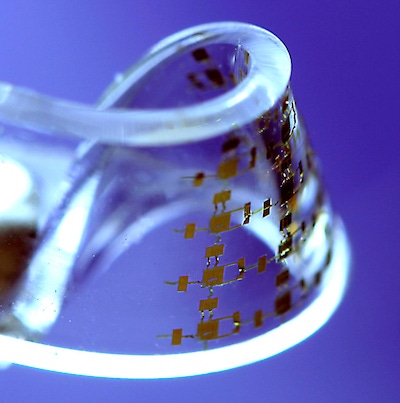Missouri S&T researchers are testing a technique called direct aerosol printing to produce stretchable, bendable electronics that could be used in wearable medical sensors, among many other applications.
January 3, 2017

The global wearable medical device market is projected to grow 18% CAGR over the next five years, reaching a value of $12 billion by 2021, according to Research and Markets (Dublin). The development of stretchable and bendable electronics could accelerate this growth, and 3D printing is a tool that could usher in this technology in ways that subtractive manufacturing can not. A paper published in the January 2017 edition of the journal Micromachines explores this topic.
|
Image courtesy John Rogers, University of Illinois/National Science Foundation. |
“Electronic components that can be elongated or twisted . . . could soon be used to power electronic gadgets, the onboard systems of vehicles, medical devices and other products,” writes Andrew Careaga on the Missouri University of Science and Technology (Missouri S&T; Rolla) website. University researchers explain how the combination of 3D printing techniques with elastomers can achieve these properties in a paper titled, “Materials, Mechanics and Patterning Techniques for Elastomer-based Stretchable Conductors.”
Overcoming mismatches between a flexible elastomer base and brittle electronic conductors is one of the primary challenges in developing stretchable electronics. An economical solution is additive manufacturing, according to Dr. Heng Pan, Assistant Professor of mechanical and aerospace engineering at Missouri S&T and co-author of the paper. He and fellow researchers are testing what they call direct aerosol printing, a process that involves spraying a conductive material on a stretchable substrate to develop sensors that can be placed on skin.
“With the increase of complexity and resolution of devices, higher requirements for patterning techniques are expected,” write the team of researchers in the paper. “Direct printing, as an additive manufacturing method, would satisfy such requirements and offer low cost and high speed in both prototyping and manufacturing. It might be a solution for cost-effective and scalable fabrication of stretchable electronics.”
The conductors could one day replace the rigid, brittle circuit boards that power many of today’s electronic devices, writes Careaga. They could be used, for example, as wearable sensors that adhere to the skin to monitor heart rate or brain activity, as sensors in clothing or as thin solar panels that could be plastered onto curved surfaces, he adds.
Before these conformable devices with embedded electronics enter the marketplace, a number of other challenges need to be overcome, however: The development of stretchable batteries to store energy and proof that the electronics and materials will perform and age well together.
About the Author(s)
You May Also Like



